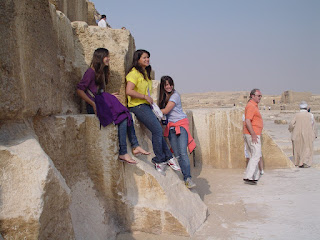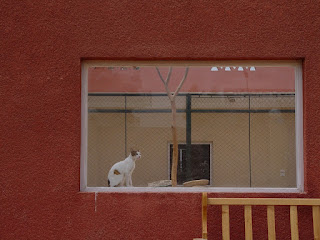
I had a nice couple from the UK staying at the farm for a weekend not long ago and they wanted, naturally, to visit the pyramids at Giza. Even more, they wanted to go inside the Great Pyramid, a trip that takes some organising these days. We got up at 6:30 am to be at the pyramids at 7:30 so that we could be first in line for the tickets to the area and the pyramids. In the old days things weren't nearly so organised and it was just a matter of showing up, but now you have to buy a ticket to the plateau and another to go into either the Great Pyramid or the Middle Pyramid at the entrance. There are two entrances, one down by the Sphinx in Nazlit Semman and one up the road from the Mena House. Once you are wandering around the plateau, it is a long dusty hike back to the ticket offices to get entrance tickets to the pyramids. We were first in line, and they got their tickets to see inside the pyramid.

They wanted to wander around for a few hours and I said that I would amuse myself at the pyramid while they did whatever it was they wanted. Sometimes my visitors want my company, but they were very independent, so I settled down to watch and photograph visitors to the pyramid. It didn't take long for the crowds and buses to begin arriving and soon I had more than enough to watch. It was a Friday morning and there were people from every nation on earth, along with Egyptian families and some school trips towing crowds of children around the area. At first I sat on the stones facing the pyramid and taking photos of people having their pictures taken. I find people posing next to one of the wonders of the ancient world to be utterly enchanting. Their delight in being there is written all over their faces and the poses are marvelous.

The photographers in the groups were so intent on their shooting that no one noticed the fact that I was shooting people rather than stones. Their subjects would climb up a few steps to stand on some of the lower stones, or they might pretend to push. Some people would simply stand quietly at the side of an enormous block of limestone resting their hands on it, as though feeling the pulse of the stone.

Moods varied from solemn and awed to hilarious enjoyment of the experience. As someone who has been visiting Giza for the past thirty years, watching the visitors awoke the delight and awe that I felt the first time I came and gazed at these unbelievably enormous structures. The first time I came to Egypt my husband brought me to the Sound and Light the first evening and the next day we came out to the pyramids with a group of his teen-aged cousins. They had all seen the pyramids before and their enjoyment of my delight was obvious. We had bought a good camera for that trip and were having a marvelous time taking photos of everything...everyone assumed that my husband was a foreigner since why would an Egyptian take pictures at the pyramids? Times have definitely changed.

As the morning progressed, I took shelter in a shady niche about three stones up the pyramid from which vantage point I watched the visitors as they faced me. It was almost ceremonial. The footing at the base of the pyramid is quite uneven and the SCA have built a wooden walkway over the rocky platform along which many of the first time visitors approach. It's a lot to take in and there is a moment for each one when they stop and try to take in the enormity of what is in front of them. From a distance they must turn their heads from left to right to see the expanse of the one face and then they must lean back, back, back to try to see all the way to the top. After a few moments of orientation, the group photographer begins to motion people to stand in front of the pyramid to commemorate the day.

I was there about four hours and have to say that I never had a moment to get bored. The parade of visitors was unending, the buses filling the parking lot never thinned out, and I took about four hundred photos that one morning. I did a lot of critical trashing of bad shots but I was left with almost one hundred that I felt were worth keeping.
 I always feel that there is a peace in the pyramids that tolerates our human foolishness. They have seen it all over the millenia. They had their centuries of glory, of neglect and even abuse, but over all they persist. I'm quite aware of my anthropormorphising large piles of stone but when you live with them as neighbours, it's easy to do. So a Friday morning watching the endless games of the pilgrims who come in wonder and delight to play out the ancient rite of celebrating these ancient observers of our history made a perfect day.
I always feel that there is a peace in the pyramids that tolerates our human foolishness. They have seen it all over the millenia. They had their centuries of glory, of neglect and even abuse, but over all they persist. I'm quite aware of my anthropormorphising large piles of stone but when you live with them as neighbours, it's easy to do. So a Friday morning watching the endless games of the pilgrims who come in wonder and delight to play out the ancient rite of celebrating these ancient observers of our history made a perfect day.copyright 2009 Maryanne Stroud Gabbani





